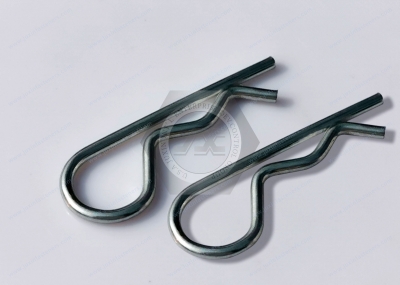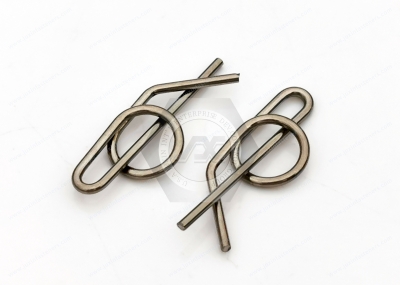Call Us
+86 136 6007 9809
Call Us
+86 136 6007 9809
Nov. 04, 2023
A cotter pin is a standard tool used to connect and secure objects. It is usually made of metal and has an opening and a pin. When using cotter pins, we need to pay attention to some correct usage methods to ensure their safety and reliability.
It is essential to choose the correct size of the cotter pin. Improper selection of size may result in the cotter pin being unable to close completely, thus failing to achieve the effect of fixing the object. Therefore, when choosing cotter pins, we need to select the correct size according to the thickness and needs of the selected object.
Cotter Pins, also known as split pins, have one prong slightly longer than the other, so they're easy to open. Bend the prongs outward to secure them. Use them to tie the ends of clevis pins and shafts to keep components in place.
Steel pins have good strength. Pins with a zinc-plated finish have some corrosion resistance. Pins with a cadmium yellow-chromate plated finish have good corrosion resistance and meet MS-24665 for dimensions, material, and finish.
18-8 stainless steel pins balance strength and corrosion resistance. They may be mildly magnetic. Passivated pins provide added protection against corrosion and oxidation.
Three hundred sixteen stainless steel pins have the best corrosion resistance of our stainless steel pins and are as strong as 18-8 stainless steel pins. They may be mildly magnetic.
Aluminum pins are one-third the weight of stainless steel pins and resist corrosion. They are nonmagnetic.
Brass pins are rust-resistant, electrically conductive, and nonmagnetic.
Four hundred nickel pins are solid and wear-resistant. They withstand salt water and caustic chemicals and may be mildly magnetic. Pins meet MS-24665 for dimensions, material, and finish. They are also known as Monel.
When using cotter pins, we must ensure that the pin enters the opening entirely and is securely fastened. If the pin does not fully penetrate the opening, then the effect of fixing the object may not be satisfactory and may easily cause loosening or falling off. Therefore, when using a cotter pin, we should appropriately push it into the opening to ensure it is firmly in place.
When the cotter pin needs to be replaced or adjusted, we should use the right tool to complete the process. Usually, we can use a pair of pliers or a wrench to help us remove or adjust the cotter pin. When doing so, we must consider the tool's strength to avoid excessive force that may damage the cotter pin or the fixed object.
Hairpin Cotter Pins, also known as hitch pin clips and R-clips, are easy to install and remove. Use them to secure the ends of clevis pins and shafts to keep components in place.
Zinc-plated steel pins have good strength and some corrosion resistance.
18-8 stainless steel pins balance strength and corrosion resistance. They may be mildly magnetic.
Three hundred sixteen stainless steel pins have the best corrosion resistance of our stainless steel pins and are as strong as 18-8 stainless steel pins. They may be mildly magnetic.
Pins that meet DIN 11024 adhere to strict standards for size and material.


We should also pay attention to the storage and maintenance of cotter pins. When not in use, they should be stored in a dry and ventilated place to avoid the effects of moisture and corrosion. If a cotter pin is rusted or damaged, we should replace or repair it in time to ensure its regular use.
We must also pay attention to some safety matters when using cotter pins. First, we should avoid placing fingers or other body parts in the opening of the cotter pin to prevent pinching or other accidental injuries. Secondly, we should pay attention to the environment and scene of use and avoid using cotter pins in unstable or dangerous places.
It is essential to use cotter pins correctly, which involves the effectiveness and safety of our fixed objects. By choosing the right size, installing and removing them correctly, maintaining them properly, and paying attention to safety matters, we can ensure that cotter pins are used correctly to improve efficiency and safety. Therefore, when using cotter pins, we should consider the above methods to guarantee reliability and safety.
Strong-Hold Hairpin Cotter Pins, a coil that makes a firmer grip than standard hairpin cotter pins to prevent accidental release. Also known as hitch pin clips and R-clips, these pins are easy to install and remove. Use them to secure the ends of clevis pins and shafts to keep components in place.
Steel pins have good strength. Those with a zinc-plated finish have some corrosion resistance.
18-8 stainless steel pins balance strength and corrosion resistance. They may be mildly magnetic.
Three hundred sixteen stainless steel pins have the best corrosion resistance of our stainless steel pins and are as strong as 18-8 stainless steel pins. They may be mildly magnetic.
If you are looking for high-quality automotive fastener screws & all kinds of plastic fasteners or technical support for structural design, please get in touch with me. Use our new Product Finder tool, download our Product Catalog, and let us help you get custom parts.adelajonly@gmail.com. Thanks. Website: www.juxinfasteners.com
Contact Us
Tel.:
+86 020 8621 0320
+86 020 3121 6067
Technical Support:
Navigation
SEND INQUIREY